Disclosure: This article contains affiliate links. We may earn a commission from purchases at no extra cost to you, which helps our travel content.
The evening air in Chiang Mai carries a symphony of aromas – fragrant lemongrass, sizzling garlic, caramelizing palm sugar, and the unmistakable punch of fish sauce. As I stand at the entrance of the Sunday Walking Street Market, I'm reminded why I've returned to this northern Thai city for the third time. There's something about Chiang Mai's culinary landscape that speaks to both sides of my heritage – the Japanese appreciation for meticulous preparation and the American love for bold flavors and casual dining experiences. For solo travelers seeking authentic connections through food, Chiang Mai offers an accessible entry point into Thai cuisine beyond the familiar pad thai and green curry. This ancient city, nestled among mountains and wrapped in centuries of Lanna culture, reveals itself most honestly through its street food – where every bite tells a story of tradition, family recipes, and the beautiful mai pen rai (never mind) attitude that makes Thailand so captivating.
Navigating Chiang Mai's Night Markets: A Solo Diner's Guide
Chiang Mai boasts several night markets, each with its own personality and culinary specialties. For first-timers, I recommend starting with the Sunday Walking Street Market along Ratchadamnoen Road in the Old City. Unlike the more tourist-oriented Night Bazaar, this weekly event draws a healthy mix of locals and visitors, creating an atmosphere that feels both authentic and accessible.
As a solo traveler, I've developed a strategy for these bustling markets: arrive early (around 5 PM) before the crowds thicken, bring small bills, and carry a reusable shopping bag for impulse purchases. My first hour is always dedicated to reconnaissance – I walk the entire length without buying, mentally noting stalls with the longest local queues. These are invariably the hidden gems.
The Saturday Walking Street on Wua Lai Road offers a slightly less crowded alternative with equally impressive food options. For weeknight grazing, the North Gate (Chang Phuak) Market hosts the famous 'Cowboy Hat Lady' whose pork leg rice (khao kha moo) has achieved legendary status among food enthusiasts.
Before setting out, I always make sure my phone power bank is fully charged. Night market food photography drains battery quickly, and you'll want plenty of juice for mapping your way back to your accommodation after dark. I've found that carrying my own set of portable utensils not only reduces plastic waste but gives vendors a smile when they see your commitment to sustainable travel.
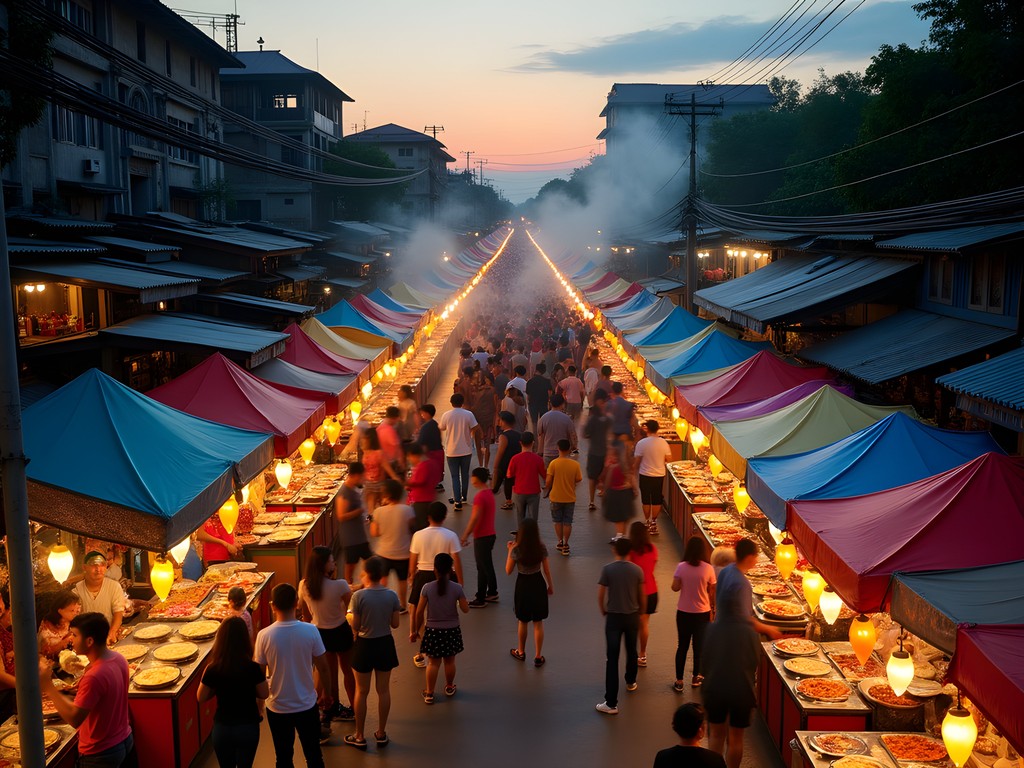
💡 Pro Tips
- Arrive at night markets around 5 PM to beat the crowds and watch vendors set up
- Bring small bills (20-100 baht notes) for easier transactions
- Look for stalls with lines of Thai customers – they know where the good stuff is
The Art of Ordering: Breaking Language Barriers
One of my favorite aspects of solo travel is how it pushes me outside my comfort zone, particularly when it comes to ordering food in a language I barely speak. In Chiang Mai, I've found that a smile, respectful wai (slight bow with hands pressed together), and a few key Thai phrases go remarkably far.
Start with sawadee ka/krap (hello), khob khun ka/krap (thank you), and the all-important mai pet (not spicy) if you're heat-sensitive. I keep these and other useful phrases in a notes app on my phone, alongside photos of dishes I want to try.
Point-and-order is perfectly acceptable at most stalls, but I've discovered that vendors light up when you attempt even basic Thai. My mixed Japanese-American features often lead to conversations about where I'm from, creating unexpected moments of connection over shared plates.
Vegetarians and vegans should learn jay (strict vegetarian/vegan) or mang sa wirat (vegetarian who may eat eggs/dairy). Be aware that fish sauce is ubiquitous in Thai cuisine, so clarify if you avoid it.
For solo travelers concerned about food safety, I follow a simple rule: eat where locals eat. Busy stalls mean high turnover of ingredients and less time for food to sit out. I also carry a small bottle of hand sanitizer and my trusty insulated water bottle filled with purified water to stay hydrated while navigating the hot markets.
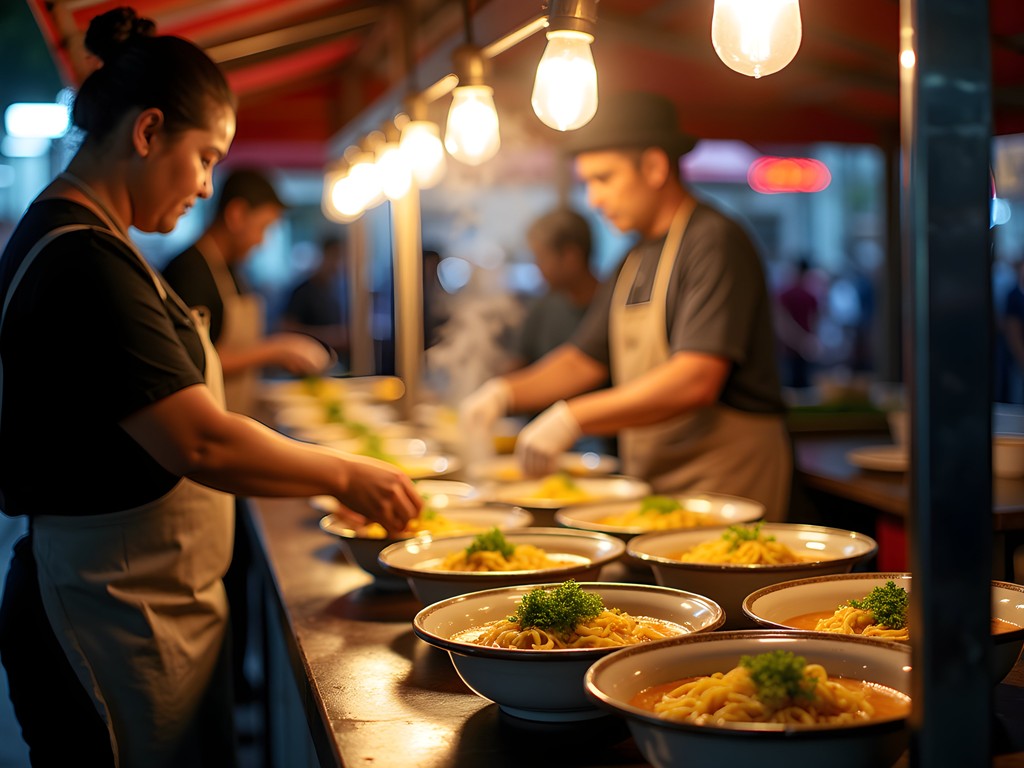
💡 Pro Tips
- Learn basic food-related Thai phrases like 'mai pet' (not spicy) and 'aroy mak' (very delicious)
- Carry a small notebook with pictures of dishes you want to try if you're shy about pronunciation
- Solo diners should sit at communal tables when possible – it's a great way to meet locals and other travelers
Must-Try Northern Thai Specialties
Northern Thai cuisine differs significantly from the dishes most foreigners associate with Thailand. The region's cooler climate and historical connections to Myanmar, Laos, and China have shaped a culinary tradition that favors herbs over spice, sticky rice over jasmine, and slow-cooked meats over quick stir-fries.
Khao soi tops my list of must-try dishes – a curry noodle soup with a complex coconut broth, boiled egg noodles, and crispy fried noodles on top. The best versions balance sweetness, spice, and tanginess perfectly. My favorite comes from a tiny stall near Wat Phra Singh where the grandmother has been making it the same way for 40 years.
Sai oua (northern Thai herb sausage) packs a fragrant punch with lemongrass, kaffir lime leaves, and galangal. Paired with nam prik noom (roasted green chili dip) and sticky rice, it's a flavor combination that haunts my dreams back in Philadelphia.
For the adventurous eater, larb khua (northern-style minced meat salad) differs from its northeastern cousin with its dried spice mix and absence of lime juice. The deep, earthy flavors reflect the region's mountainous terrain.
Don't miss kanom jeen nam ngiaw, rice noodles in a tangy tomato-based pork broth with blood cubes and vegetables. It sounds intimidating but offers a perfect balance of flavors that showcases northern Thailand's unique culinary perspective.
After sampling so many intense flavors, I find myself craving something sweet. Fresh fruit abounds at markets, but my weakness is khanom krok – coconut pudding cups made in special cast iron pans. Watching vendors skillfully pour and flip these treats is almost as satisfying as eating them.

💡 Pro Tips
- Try khao soi during the day when specialized shops are open – night market versions are often simplified
- Order sticky rice (khao niew) instead of steamed rice with northern Thai dishes for an authentic experience
- Save room for kanom krok (coconut pudding cups) – they're best eaten fresh off the griddle
Beyond the Markets: Hidden Neighborhood Gems
While Chiang Mai's night markets rightfully steal the spotlight, some of my most memorable meals have come from unassuming neighborhood spots where tourists rarely venture. These discoveries came through practicing what I call 'mindful wandering' – setting out on foot with no particular destination but with all senses alert to possibilities.
Nimmanhaemin Road (or 'Nimman' as locals call it) is known for trendy cafes and boutiques, but venture down the small sois (lanes) branching off the main road to find family-run eateries serving home-style northern Thai cooking. Soi 7 yielded a tiny restaurant where I watched a grandmother pound som tam (papaya salad) to order while her grandson grilled perfect skewers of moo ping (marinated pork).
The area around Chiang Mai University reveals another food landscape entirely – one catering to student budgets but rich in flavor. Here I discovered boat noodles so intensely aromatic that I returned three days in a row, each time bringing my travel journal to record the layered flavors and ingredients I could identify.
For solo female travelers concerned about dining alone at night, these neighborhood spots often feel more comfortable than tourist areas. I've found Thai people to be incredibly hospitable to solo diners, sometimes sending over extra dishes 'for you to try' or engaging in conversation despite language barriers.
The Santitham neighborhood north of the Old City remains largely untouched by tourism but harbors some exceptional food stalls, particularly for khao man gai (chicken rice) and joke (rice porridge) – perfect breakfast options before a day of exploring.
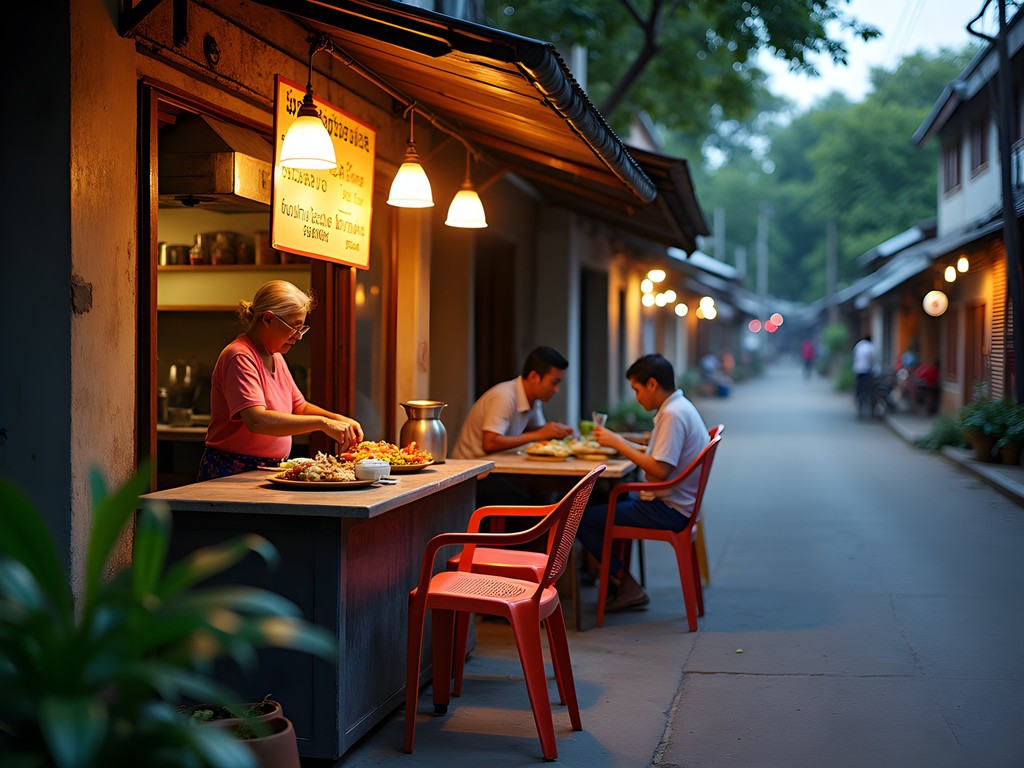
💡 Pro Tips
- Use the Grab app to save your accommodation location before heading out to explore – neighborhood spots rarely appear on tourist maps
- Look for places filled with Thai office workers during lunch hours (12-1pm) for authentic, reasonably-priced meals
- Ask your accommodation host for their personal favorite local restaurant – not just what they recommend to tourists
Mindful Eating: Slowing Down to Taste Chiang Mai
In our rush to document meals for social media or check dishes off culinary bucket lists, we sometimes forget to truly taste what we're eating. As someone who practices mindfulness in various aspects of life, I've found street food adventures particularly suited to mindful eating exercises.
Before my first bite of a new dish, I pause to appreciate its visual composition and inhale its aroma. Thai cuisine is particularly rewarding for this practice, as it deliberately balances appearance, smell, and the essential flavor components of salty, sweet, sour, and spicy.
I've developed a habit of taking a moment between bites to identify individual ingredients and consider the cultural context of what I'm eating. This slowing down has transformed my relationship with food photography as well – instead of rushing to snap the 'perfect shot' while food gets cold, I first connect with the dish, then capture one thoughtful image that tells its story.
Solo travelers have a unique advantage here – without conversation to distract, we can fully immerse in sensory experiences. I often leave my wireless earbuds in my bag during market explorations, preferring instead to absorb the sizzles, chatter, and ambient sounds that create the full sensory landscape of Thai street food culture.
This mindful approach extends to interactions with vendors. Rather than treating transactions as merely transactional, I try to be fully present – making eye contact, expressing gratitude, and sometimes asking about the history of their recipes. These small moments of connection have led to some vendors recognizing me on return visits, occasionally slipping extra portions or special items into my order with a knowing smile.
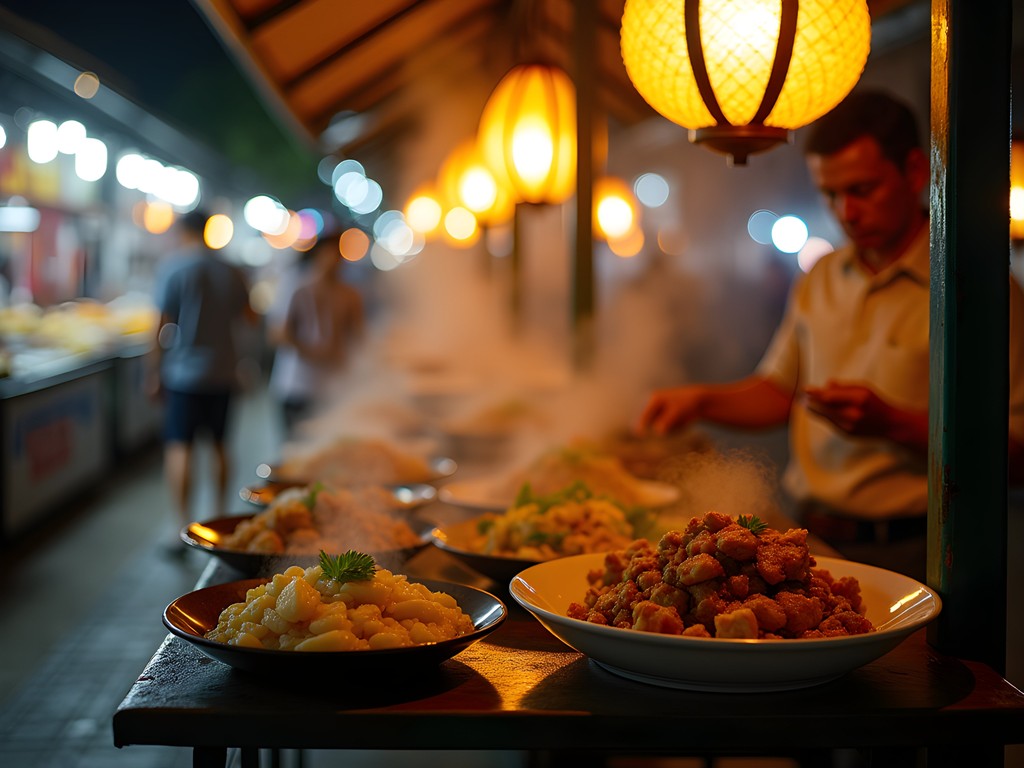
💡 Pro Tips
- Put your phone away after taking photos and focus entirely on the flavors and textures of each dish
- Try identifying individual herbs and spices in complex dishes like curries and soups
- Practice the Thai concept of 'gin len' (eating for fun) by ordering small portions from multiple vendors rather than one large meal
Final Thoughts
Chiang Mai's street food scene offers more than just sustenance – it provides a window into northern Thai culture, history, and the warmth of its people. For solo travelers willing to venture beyond comfort zones and engage with local food traditions, the rewards are immeasurable. I've found that my bicultural perspective helps me appreciate both the technical precision of Thai cooking and the social aspects of shared meals, even when dining alone. As you plan your own culinary adventure in Chiang Mai, remember that the most memorable food experiences often come not from following a rigid checklist of 'must-try' dishes, but from remaining open to serendipitous discoveries and connections. Let your senses guide you through the labyrinth of aromas and flavors, and don't forget to look up from your plate occasionally to absorb the beautiful chaos of Thai market life swirling around you. Gin hai aroi na – eat deliciously!
✨ Key Takeaways
- Chiang Mai's different night markets each have unique specialties and atmospheres worth exploring
- Northern Thai cuisine differs significantly from central and southern Thai food most foreigners know
- Solo travelers can use food as a gateway to meaningful cultural connections despite language barriers
- Mindful eating enhances the street food experience by deepening appreciation for flavors and traditions
📋 Practical Information
Best Time to Visit
year-round (though November-February offers milder temperatures)
Budget Estimate
$15-30 USD per day for street food exploration
Recommended Duration
3-5 days minimum
Difficulty Level
Beginner


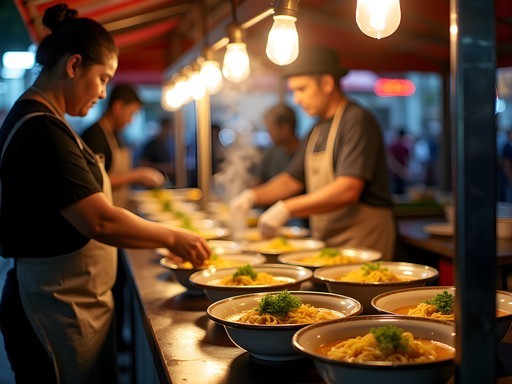
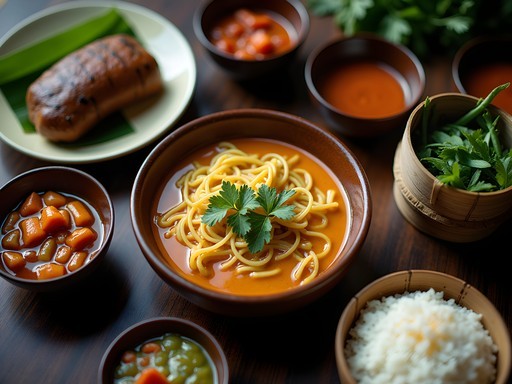





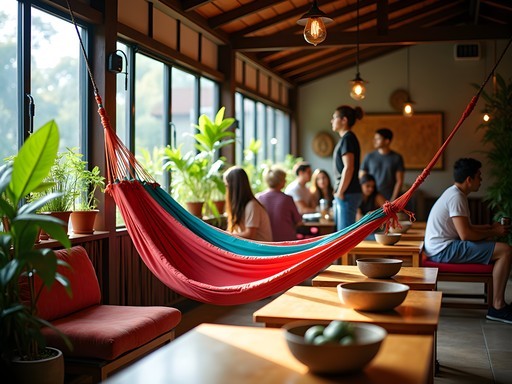
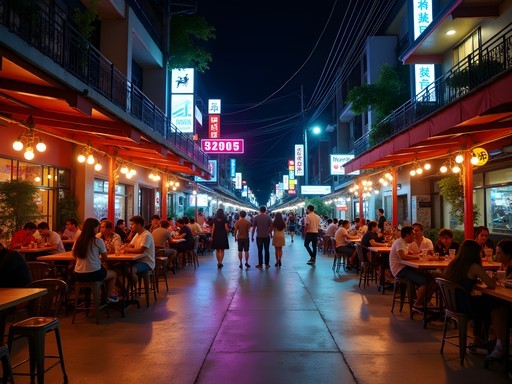




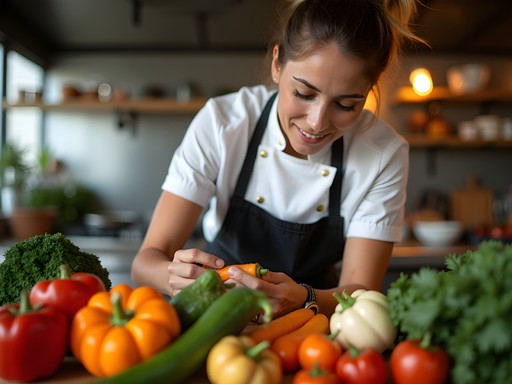
Comments
tripperson
Those neighborhood gems are the real deal. Found a place serving khao kha moo down a random alley that changed my life.
stardiver2529
Did you find any good vegetarian options? I'm heading there next month and worried about finding meat-free dishes at the street stalls.
Elizabeth Stephens
Absolutely! Look for the yellow flags with red text that indicate vegetarian food. Chiang Mai has a strong Buddhist influence, so many vendors understand 'jay' (vegan) or 'mang sa wirat' (vegetarian). The Ploen Ruedee Night Market has several dedicated vegetarian stalls. Also try the vegetarian khao soi at Pun Pun near Wat Suan Dok - incredible!
Sage Dixon
Elizabeth - what a fantastic guide! I was in Chiang Mai during Songkran last year and discovered this incredible pattern: follow the university students for the best affordable eats. They led me to this hole-in-the-wall place near Chiang Mai University serving the most incredible tom saep (spicy pork soup) I've ever tasted. For anyone visiting, don't skip the Nimman area - it's more upscale but has these amazing fusion food stalls blending traditional northern Thai with modern techniques. There's one called 'Rustic & Blue' that does this khao soi with sous-vide egg that will blow your mind. Also, the morning markets are just as incredible as the night ones but totally different vibe. Ton Payom Market near Chiang Mai Gate has these incredible jok (rice porridge) vendors that set up before sunrise. Perfect way to start a day of exploring!
islandadventurer366
Those hidden neighborhood spots sound amazing! Saving this for my trip in November!
bluebuddy
Any tips for avoiding stomach issues? Street food looks amazing but I'm nervous!
Sage Dixon
Look for busy stalls where locals eat - high turnover means fresh food! Also, stalls where the person handling money isn't the same one handling food. I've eaten street food across Thailand and never had issues with this approach.
bluebuddy
Thank you! That's really helpful advice.
tripperson
Just got back from Chiang Mai last week. The Cowboy Hat Lady's pork is LEGIT.
Bryce Diaz
Elizabeth, your post brought me right back to my own Chiang Mai adventures last year! That sensory overload at the night markets is something you just can't prepare for. I still dream about the sai oua (northern Thai sausage) from this tiny stall run by an elderly couple at the Sunday Walking Street. The husband grilled while the wife chatted with everyone in a mix of Thai and broken English. They told me they'd been in that exact spot for 27 years! One tip for fellow solo travelers - I found the food courts at the markets to be great for trying multiple dishes without the awkwardness of sitting alone. And don't miss the khao kha moo (stewed pork leg) at the Chang Puak Gate stall - just look for the lady in the cowboy hat!
winterpro
That cowboy hat lady is famous! Did you find the language barrier difficult to navigate when ordering food? I'm planning a trip but speak zero Thai.
Bryce Diaz
Not at all! Most vendors at popular markets have picture menus or English translations. I also used the Thai phrasebook which had a food section with common dishes. But honestly, pointing and smiling works wonders too!
journeychamp
This post has me DROOLING! Those khao soi photos are absolutely gorgeous. Adding Chiang Mai to my bucket list RIGHT NOW!
roamdiver
If you're heading to Chiang Mai, definitely download translation app and save Thai language offline. Saved me so many times at the food stalls! The photo translation feature works great for menus too.
coffeeking9256
Good tip! I just used pointing and smiling 😂
coffeeking9256
Those sai oua sausages changed my life! Great post!
Venture X
Premium card with 2X miles, $300 travel credit, Priority Pass